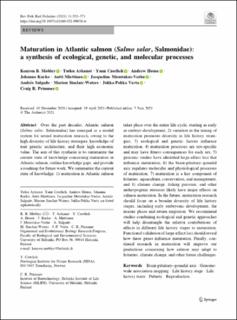| dc.contributor.author | Mobley, Kenyon B. | |
| dc.contributor.author | Aykanat, Tutku | |
| dc.contributor.author | Czorlich, Yann | |
| dc.contributor.author | House, Andrew | |
| dc.contributor.author | Kurko, Johanna | |
| dc.contributor.author | Miettinen, Antti | |
| dc.contributor.author | Moustakas-Verho, Jacqueline | |
| dc.contributor.author | Salgado, Andrés | |
| dc.contributor.author | Sinclair-Waters, Marion | |
| dc.contributor.author | Verta, Jukka-Pekka | |
| dc.contributor.author | Primmer, Craig R. | |
| dc.date.accessioned | 2022-03-24T14:24:53Z | |
| dc.date.available | 2022-03-24T14:24:53Z | |
| dc.date.created | 2021-07-15T15:31:52Z | |
| dc.date.issued | 2021 | |
| dc.identifier.citation | Reviews in Fish Biology and Fisheries. 2021, . | en_US |
| dc.identifier.issn | 0960-3166 | |
| dc.identifier.uri | https://hdl.handle.net/11250/2987452 | |
| dc.description.abstract | Over the past decades, Atlantic salmon (Salmo salar, Salmonidae) has emerged as a model system for sexual maturation research, owing to the high diversity of life history strategies, knowledge of trait genetic architecture, and their high economic value. The aim of this synthesis is to summarize the current state of knowledge concerning maturation in Atlantic salmon, outline knowledge gaps, and provide a roadmap for future work. We summarize the current state of knowledge: 1) maturation in Atlantic salmon takes place over the entire life cycle, starting as early as embryo development, 2) variation in the timing of maturation promotes diversity in life history strategies, 3) ecological and genetic factors influence maturation, 4) maturation processes are sex-specific and may have fitness consequences for each sex, 5) genomic studies have identified large-effect loci that influence maturation, 6) the brain-pituitary–gonadal axis regulates molecular and physiological processes of maturation, 7) maturation is a key component of fisheries, aquaculture, conservation, and management, and 8) climate change, fishing pressure, and other anthropogenic stressors likely have major effects on salmon maturation. In the future, maturation research should focus on a broader diversity of life history stages, including early embryonic development, the marine phase and return migration. We recommend studies combining ecological and genetic approaches will help disentangle the relative contributions of effects in different life history stages to maturation. Functional validation of large-effect loci should reveal how these genes influence maturation. Finally, continued research in maturation will improve our predictions concerning how salmon may adapt to fisheries, climate change, and other future challenges. Keywords Brain-pituitary–gonadal axis Genomewide association mapping Life history stage Life history traits Puberty Reproduction | en_US |
| dc.language.iso | eng | en_US |
| dc.rights | Navngivelse 4.0 Internasjonal | * |
| dc.rights.uri | http://creativecommons.org/licenses/by/4.0/deed.no | * |
| dc.subject | Brain-pituitary | en_US |
| dc.subject | gonadal axis | en_US |
| dc.subject | Genome | en_US |
| dc.subject | wide association mapping | en_US |
| dc.subject | Life history stage | en_US |
| dc.subject | Life history traits | en_US |
| dc.subject | Puberty | en_US |
| dc.title | Maturation in Atlantic salmon (Salmo salar, Salmonidae): a synthesis of ecological, genetic, and molecular processes | en_US |
| dc.type | Peer reviewed | en_US |
| dc.type | Journal article | en_US |
| dc.description.version | publishedVersion | en_US |
| dc.rights.holder | © 2021 The Authors | en_US |
| dc.subject.nsi | VDP::Zoologiske og botaniske fag: 480 | en_US |
| dc.subject.nsi | VDP::Zoology and botany: 480 | en_US |
| dc.source.pagenumber | 523-571 | en_US |
| dc.source.volume | 31 | en_US |
| dc.source.journal | Reviews in Fish Biology and Fisheries | en_US |
| dc.identifier.doi | 10.1007/s11160-021-09656-w | |
| dc.identifier.cristin | 1921884 | |
| dc.relation.project | Andre: Academy of Finland 307593, 302873 and 284941 | en_US |
| dc.relation.project | EC/H2020/742312 | en_US |
| dc.relation.project | Andre: University of Helsinki | en_US |
| cristin.ispublished | true | |
| cristin.fulltext | original | |
| cristin.qualitycode | 1 | |

